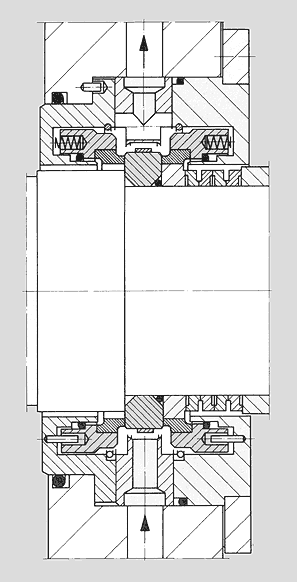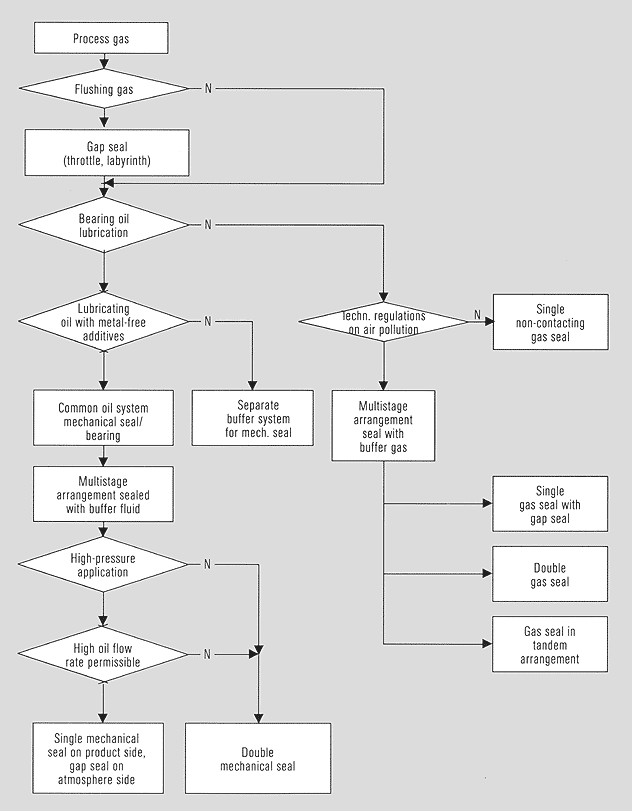| Turbo compressors | ||
Turbo compressors are high-speed machines used in a large number of industrial sectors to compress all manner of gases. Examples are: - air fractionation systems - central compressed air system - sewage works - chemical, petrochemical and other technical processes - coal gasification - refineries - mineral oil recovery - refrigeration circuits - heat recovery systems - steel works - hydrogen production - flue gas desulphurization systems. In view of their fields of application, the requirements on compressors are usually very high. The same is true for their sealing systems, which need to cope with such conditions as high speeds, centrifugal loading and excitation of vibrations. Oil supply systems are critical for the operational reliability of turbo compressors. Oil consumers are bearings, couplings and mechanical seals (non-contacting gas seals are an exception). Lubricating oil systems and buffer oil systems can be totally separated, but it is also possible for the two systems to be combined. Sealing systems and their modes of operation
These consist of several sealing points that are installed mostly in the stationary part of the compressor. The points of the labyrinth are throttling sections where the pressure is reduced. This type of sealing is employed when buffer gas is allowed to enter the process gas or process gas leakage. It is possible to prevent leakage to the atmosphere by using an additional mechanical seal that functions simultaneously as a shut-down seal. |
Here the pressure is reduced by way of an annular throttling gap. In combination with a pressure-fed buffer medium (> product pressure), the escape of process gas is prevented. Single-acting mechanical seals are often fitted downstream on the atmosphere side to act as safety and shut down seals.
Pressure is reduced by way of a seal face with axial spring loading. Mechanical seals are used under conditions of high gas pressures, when no leakage of process gas is allowed and when the system must be gas-tight at standstill.
are employed as primary and shut-down seals in combinations with a floating ring or labyrinth seal. The range of application extends to approximately 10 bar and 100 m/s. Buffer oil pressure is reduced by way of a throttle (e. g. a floating ring) on the atmosphere side.
are employed specially for high differential pressures (100 bar) and high sliding velocities (100 m/s). The advantage of the double-acting mechanical seal is that the part on the atmosphere side serves simultaneously as a safety seal (protecting the bearing zone against penetration by medium in the event of the primary seal becoming defective). If the (product-compatible) buffer oil has no lubricating effect, a separate lubrication system is needed for the bearing.
|
|
Single mechanical seal for high-duty turbo compressors. - operating limits: 100 m/s and 100 bar - balanced - rotating, solid counter ring made of reaction-sintered silicon carbide - metallic safety bandage prevents sudden seal failure if the counter ring breaks - the torque is channelled by friction locking through the axial bracing - stationary seal face made of silicon - impregnated electro-graphite - narrow sealing-width reduces frictional loss and heat generation - multiple spring backing - O-rings secured on two sides against extrusion - smooth contours ensure uniform flushing of seal parts requiring cooling - product pressure keeps the seal closed at standstill.
|
Double mechanical seal for a turbo compressor. Layout and geometry similar to the single-acting mechanical seal. Design features and operating limits are identical |
|
 |
 |
Turbo compressor seal selection by various requirement
criteria Turbo compressor
in a city's thermal power station |